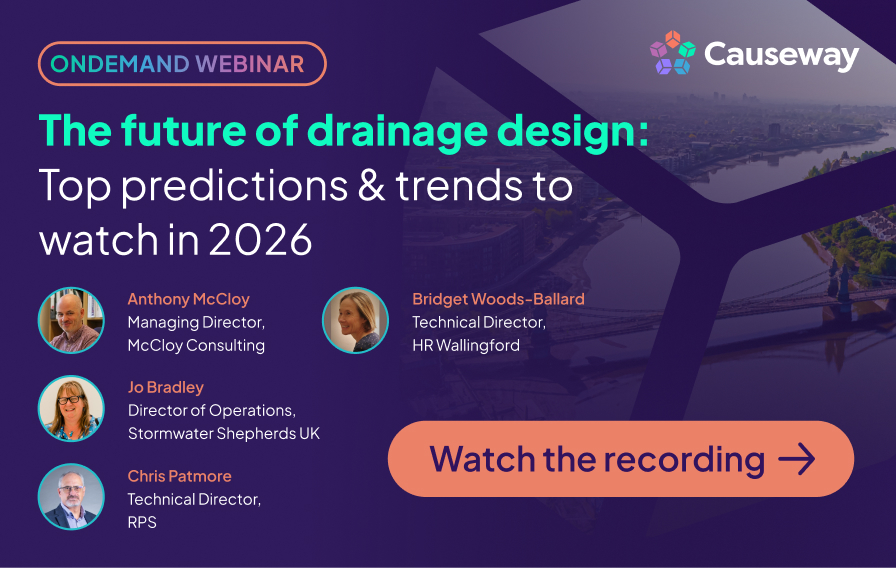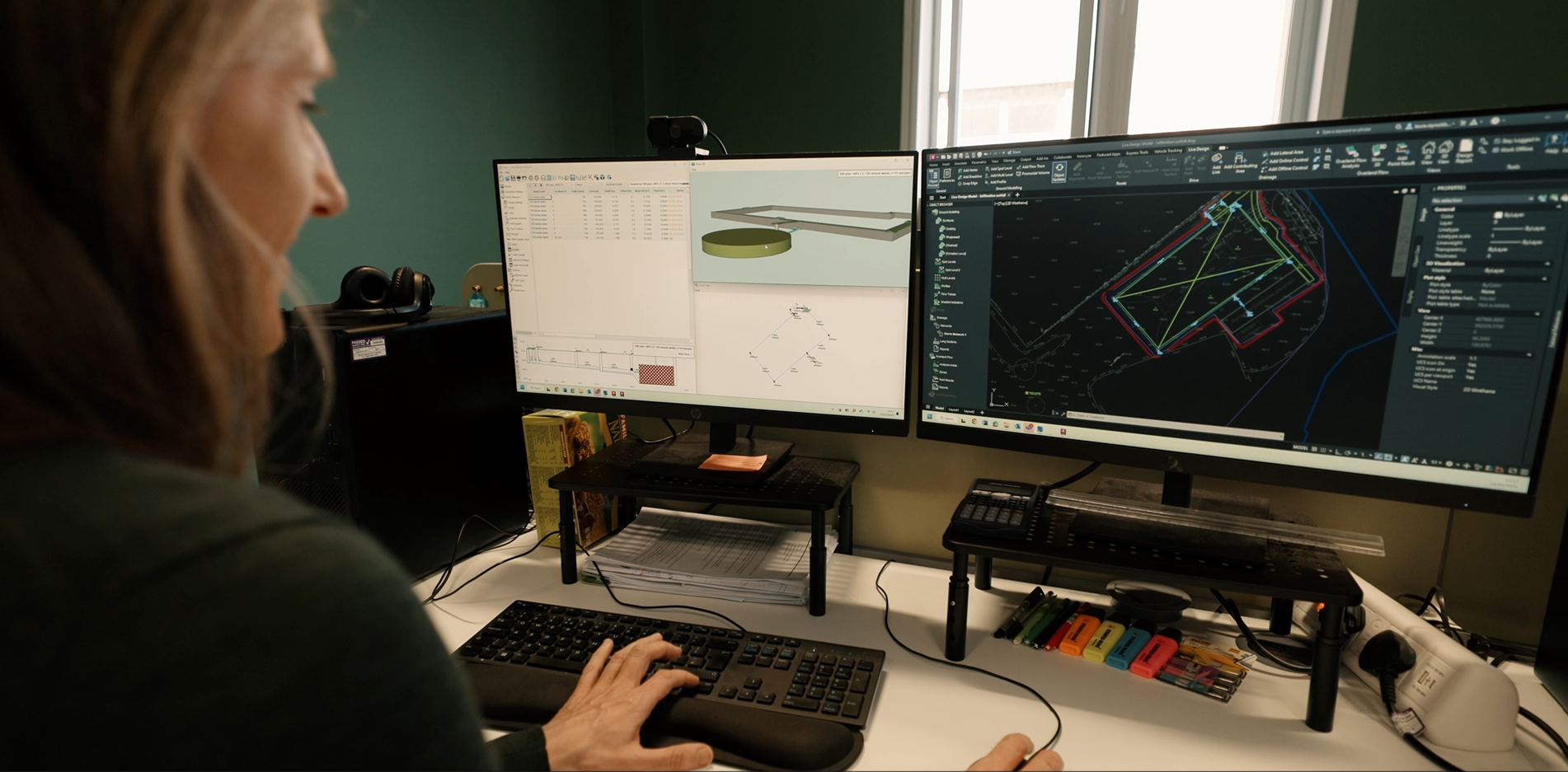Urban flooding is an increasingly significant problem due to climate change and urban expansion. As professionals in the field of drainage and urban planning, you are likely aware of the challenges posed by heavy rainfall and inadequate drainage systems. The implementation of Schedule 3 to the Flood and Water Management Act 2010, particularly around making sustainable drainage systems (commonly known as SuDS) a mandatory requirement, presents an effective solution to mitigate these impacts. This article explores how SuDS and the right design software can transform the future of drainage design.
Understanding SuDS and their importance
Sustainable Drainage Systems (SuDS) are designed to manage rainfall close to where it falls, rather than relying on traditional drainage systems that often contribute to flooding and water pollution. SuDS features include permeable pavements, green roofs, swales, and detention basins, all of which mimic natural drainage processes.
Understanding SuDS and its role in urban flooding
SuDS are designed to manage surface water runoff locally. They replicate natural drainage processes to reduce the volume and rate of runoff, improving water quality and enhancing urban environments. Some of the most common SuDS features include permeable pavements, green roofs, swales, and detention basins, all working together to manage rainwater effectively.
Understanding SuDS and its role in urban flooding
With urban areas expanding and the frequency of intense rainfall events increasing, traditional drainage systems often fail to cope, leading to flooding. SuDS helps to:
- Reduce Flood Risk: By allowing water to infiltrate into the ground or be stored temporarily, SuDS reduce the likelihood of flooding.
- Enhance Water Quality: SuDS filters pollutants from runoff, improving the quality of water entering rivers and streams.
- Promote Biodiversity: Green SuDS features create habitats for wildlife, supporting urban biodiversity.
- Provide Amenity Spaces: Well-designed SuDS can even enhance the urban landscape, providing green spaces for communities or improving air quality.
Sustainable Drainage Systems Software plays a crucial role in designing effective SuDS features that address urban flooding.
Schedule 3 of the flood and water management Act 2010
In his review of the Summer 2007 floods, Sir Michael Pitt highlighted SuDS as a highly effective method to mitigate surface water flooding and alleviate pressure on sewer systems. These recommendations were later incorporated into Schedule 3 of the Flood and Water Management Act, which was enacted in April 2010. The core purpose of Schedule 3 is to make the adoption of SuDS into new developments mandatory, including:
- All developments of more than one home or covering an area of more than 100 square meters include SuDS.
- Developers seek approval from the SuDS Approval Body (SAB) before construction begins.
The impact of Schedule 3 on local authorities and consultancies
For local authorities and LLFAs, there’s a significant increase in responsibility and power for them. They will need to engage with developers to ensure that new builds are designed with flood risk in mind and that SuDS are incorporated in submissions. This requires additional resources and investment to carry out the necessary assessments.
It’ll also become important for engineering consultants to work effectively with LLFAs and other stakeholders to secure approvals. Engineers designing SuDS need to engage from the early stages of planning through to detailed design rather than as an afterthought.
The changes to Schedule 3 represent a shift towards more sustainable and resilient designs. While SuDS will improve flood risk management, it also requires investment in resources and staff from all stakeholders.
For more details on Schedule 3, visit the UK Government’s official page on flood risk management.
The role of sustainable drainage systems software
When it comes to creating well-designed SuDS, early engagement between developers and local authorities can have a significant positive impact on the ability of SuDS to deliver many benefits. There are design tools like Causeway Flow to enable engineers and local planning authorities to easily and accurately design, review and approve SuDS in accordance with the SuDS manual C753
Best practices for designing SuDS
Ensuring your SuDS designs are effective and compliant requires adherence to best practices in sustainable drainage design. Here are some key considerations:
Conduct comprehensive site assessments
Understanding the site’s characteristics, including soil type, topography, and existing drainage patterns, is crucial for effective SuDS design. A thorough site assessment will inform the selection and placement of SuDS features.
Integrate SuDS early in the design process
Incorporating SuDS from the outset allows for a more holistic approach to site planning. Early integration ensures that SuDS features are seamlessly woven into the overall design, maximising their effectiveness.
Use advanced modeling tools
Leveraging advanced modelling tools helps predict how SuDS features will perform under various conditions. These tools can simulate rainfall events, predict runoff volumes, and optimize the placement of SuDS components.
Engage stakeholders
Effective SuDS implementation requires collaboration with stakeholders, including planners, developers, and the local community. Engaging stakeholders early in the process helps identify potential challenges and opportunities, ensuring a smoother path to compliance.
Regularly review and update designs
Regulations and site conditions can change over time. Regularly reviewing and updating your SuDS designs ensures they remain compliant and effective.
Effective SuDS implementation
Example: Urban development in Wales:
A notable example of successful SuDS implementation is an urban redevelopment project in Wales. This project incorporated various SuDS features to manage surface water sustainably and meet regulatory compliance.
Project Highlights:
- Permeable Pavements: Used in parking areas and pedestrian paths to reduce runoff.
- Green Roofs: Installed on buildings to absorb rainfall and provide insulation.
- Swales and Detention Basins: Integrated into the landscape design to manage runoff and create green spaces.
- Community Engagement: Involved local residents in the planning process to ensure the SuDS features met both functional and aesthetic needs.
Outcome: The project successfully reduced flood risk, improved water quality, and enhanced the urban environment, demonstrating the effectiveness of well-designed SuDS.
For more on SuDS regulations in Wales, visit the Welsh Government’s SuDS page.
Leveraging Causeway’s sustainable drainage systems software
At Causeway, we offer advanced tools to help you design and implement compliant and effective SuDS. Our Sustainable Drainage Systems Software is tailored to meet the challenges of modern urban drainage design.
Causeway Flow
Causeway Flow is a comprehensive hydraulic modelling solution for analysing and designing storm and foul water drainage networks. It allows you to create detailed, adaptable designs that meet regulatory standards.
Explore Causeway Flow for your SuDS design needs.
Expert support
Our team of experts is on hand to help you navigate the complexities of SuDS regulations and design. From initial site assessments to final design approvals, we provide the support you need to ensure your projects are compliant and effective.
Contact us to book a discovery call and learn how we can support your SuDS projects.
Conclusion and reflection
The future of drainage design lies in the adoption of Sustainable Drainage Systems (SuDS) and compliance with Schedule 3. By leveraging advanced Sustainable Drainage Systems Software and adhering to best practices, professionals can create effective, sustainable drainage solutions that mitigate the impacts of urban flooding and improve urban environments.
Sustainable Drainage Systems Software is essential for designing and implementing compliant and effective SuDS features.
Ready to future-proof your projects with advanced SuDS designs? Book a discovery call with Causeway today and see how our Sustainable Drainage Systems Software can help you achieve your goals.



